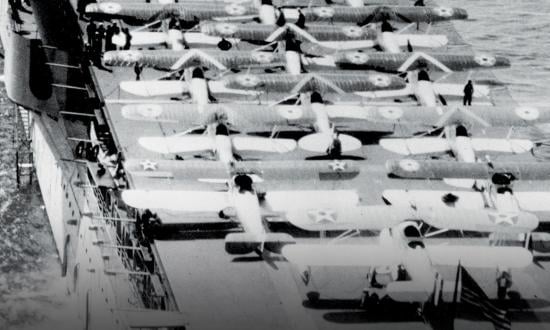At 20 years old in 1917, Alfred M. Pride left his Tufts Engineering School campus for the Boston Navy Yard to enlist in the Naval Reserve.
“What do you want to be?”
“I don’t know. I am an engineering student.”
“What’s a piston ring made out of?”
“Steel.”
“No, cast iron. You’re a machinist’s mate second class.”
Pride moved swiftly from patrol boat duty, to aviation training, to the Naval Reserve Flying Corps conducting antisubmarine patrols off the French coast, then on to gunfire-spotting duty in aircraft launched from battleships.
In learning to fly landplanes, he served under Lieutenant Commander Godfrey Chevalier, naval aviator number seven. Pride transferred to the regular Navy as a new era was dawning.
“Chevalier and Lieutenant Commander Ken Whiting had figured out that we’d better get a carrier in the Navy,” he recalls in this edited excerpt from his oral history published by the U.S. Naval Institute. “They asked for the USS Mount Vernon [ID-4508], the former German liner Kronprinzessin Cecilie, because they wanted a big ship. But they were granted the collier USS Jupiter [CV-3]. She was sent to the navy yard at Norfolk to be converted into a carrier and named the USS Langley [CV-1].”
Chevalier made the first landing on the Langley. Pride made the second. But the carrier’s original plans had no provisions for arresting gear.
Chevalier walked up to me one day and said, “You make up a gear to stop the airplanes on the Langley.”
As I would get ideas, I would have to go to Norfolk to tell the draftsmen what we’d better put in the ship. I had to work fast.
The ship first had wires across the deck with sandbags on either side. A plane’s tailhook would snag wire after wire and drag more sandbags until it stopped. Pride eventually developed a system of horizontal arresting wires attached to cast-iron weights suspended from the towers that supported the flight deck.
The weights had a great advantage over the initial sandbags and wires in that the system was self-contained. If the ship lost power, you could still fly airplanes after the wire had been pulled out.
You had to get the wire back into battery; the weights took care of that. It had a come-along arrangement. The wire would play out, but then you could control its coming back.
She came back from overhaul a year later, and much better designed weights were put in, down in one of the holds of the ship. The landing area was about 256 feet long. On the earliest design we graduated the weights; the top weight was the lightest and the bottom was the heaviest. A light plane would drag the gear out a way. When the top weight had moved up a bit, it picked up another weight. As planes became faster and larger, more adjustment became necessary.
After I finished a postgraduate course at MIT, I was ordered to the USS Lexington [CV-2] to put her in commission. I was the flight deck officer. We had this fellow Carl Norden, a Navy consultant who designed the Norden bombsight. He had been engaged by the Navy to have a much more sophisticated system of stopping the aircraft, one that was adjustable for different weights and speeds of airplanes.
He had designed a system that used a winch at each end of the crosswire, hooking into the Waterbury speed gear that put pressure on a big brake. There was an inherent difficulty with this gear. If the plane landed off center, it was inclined to go still further off center. In fact, it wanted to go over the side.
At the end of my cruise on the Lexington, I was ordered back to Norfolk to design another gear that wouldn’t have these difficulties. I designed the hydraulic gear that was a much more sophisticated version, the forerunner of the gear that is still used. The basic principle is still the same.








